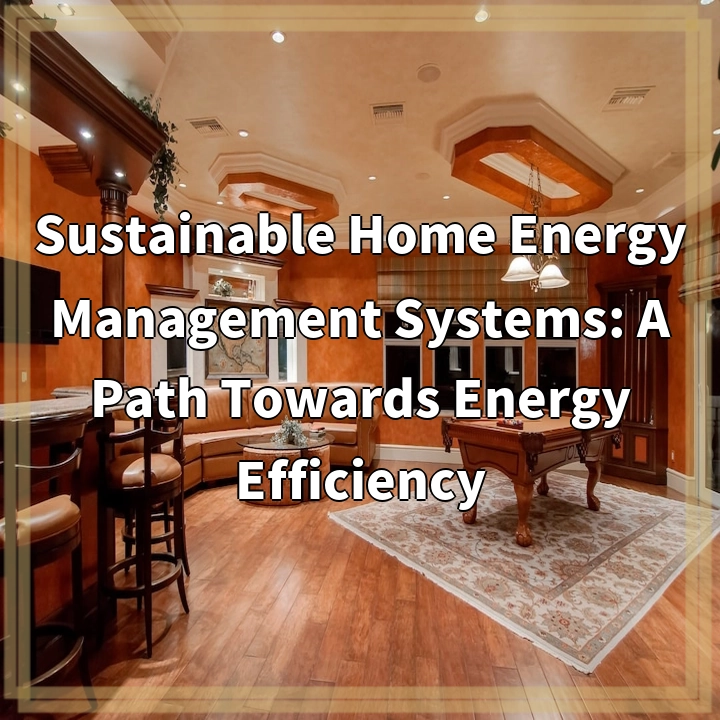
What is Sustainable Home Energy Management Systems?
Sustainable Home Energy Management Systems (SHEMS) are integrated technological solutions designed to optimize energy consumption and efficiency within residential buildings. These systems employ various devices, sensors, and software to monitor and control energy usage, aiming to reduce overall household energy consumption, increase energy efficiency, and promote sustainable living.
Real-World Problems Associated with Sustainable Home Energy Management Systems
While SHEMS offer promising benefits in terms of energy savings and environmental impact reduction, they do pose some challenges that need to be addressed:
1. Initial Costs and Investment:
Implementing a comprehensive SHEMS can involve significant upfront costs, including the purchase and installation of devices such as smart meters, energy monitoring systems, and home automation technologies. This initial investment can deter some homeowners from adopting these systems, especially those with limited financial resources.
2. Technical Complexity:
Home energy management systems require careful installation, configuration, and integration with existing building infrastructure. This can potentially pose technical challenges, particularly for homeowners who lack technical expertise or support. The complexity of these systems can discourage widespread adoption and hinder their effective utilization.
3. Data Privacy and Security:
SHEMS rely on collecting and analyzing vast amounts of data related to energy consumption patterns and household routines. This dependency raises concerns regarding data privacy and security. Users need assurance that their personal data will be protected from unauthorized access or misuse, which may be a barrier to adopting these systems.
4. User Engagement and Behavior:
In order to achieve optimal energy savings, active user engagement is crucial. However, changing consumer behaviors and habits regarding energy usage can be challenging. Adopting sustainable practices and regularly interacting with SHEMS can require a significant shift in mindset and lifestyle, which may be met with resistance or indifference from homeowners.
5. Integration and Compatibility:
Integrating different components of a SHEMS, such as energy monitoring devices, smart appliances, and renewable energy systems, can sometimes be problematic due to compatibility issues. Ensuring seamless communication and compatibility between various devices and systems is essential for a successful home energy management system.
Despite these challenges, Sustainable Home Energy Management Systems have the potential to revolutionize residential energy consumption and significantly contribute to global energy sustainability efforts, ultimately leading us towards a more energy-efficient future.

Solutions for Sustainable Home Energy Management Systems
While there are challenges associated with Sustainable Home Energy Management Systems (SHEMS), there are also solutions that can help overcome these obstacles:
1. Financial Incentives and Support:
Government agencies and energy providers can offer financial incentives, such as subsidies or tax breaks, to encourage homeowners to invest in SHEMS. Grant programs, low-interest loans, and partnerships with renewable energy companies can also help make these systems more affordable and accessible to a wider range of homeowners.
2. User-Friendly and Simplified Interfaces:
Developers of SHEMS can focus on designing user-friendly interfaces that require minimal technical expertise to operate. By providing clear instructions, intuitive controls, and easy-to-understand analytics, homeowners can effectively monitor and control their energy consumption without feeling overwhelmed by the technical complexities.
3. Data Privacy and Security Measures:
Efforts should be made to establish robust data privacy and security protocols for SHEMS. Regulatory bodies and system developers can prioritize the encryption of data, secure network connections, and transparent data management practices. Assuring homeowners of the safety and confidentiality of their personal information encourages trust and wider adoption of these systems.
4. Education and Awareness Campaigns:
Raising awareness about the benefits of SHEMS and educating homeowners on how to use them effectively can help overcome behavioral barriers. Providing information on energy-saving tips, demonstrating cost savings, and highlighting environmental benefits can motivate homeowners to actively engage with these systems and adopt sustainable energy practices.
5. Industry Standards and Interoperability:
Standardizing communication protocols and ensuring interoperability between different components and devices of SHEMS is crucial. Manufacturers and developers should collaborate to establish industry-wide standards, allowing homeowners to easily integrate new technologies and devices into their existing systems, without compatibility issues.
By implementing these solutions, we can address the challenges associated with Sustainable Home Energy Management Systems and pave the way for more widespread adoption. Embracing these systems not only benefits individual households but also contributes to global energy efficiency and sustainability goals.















